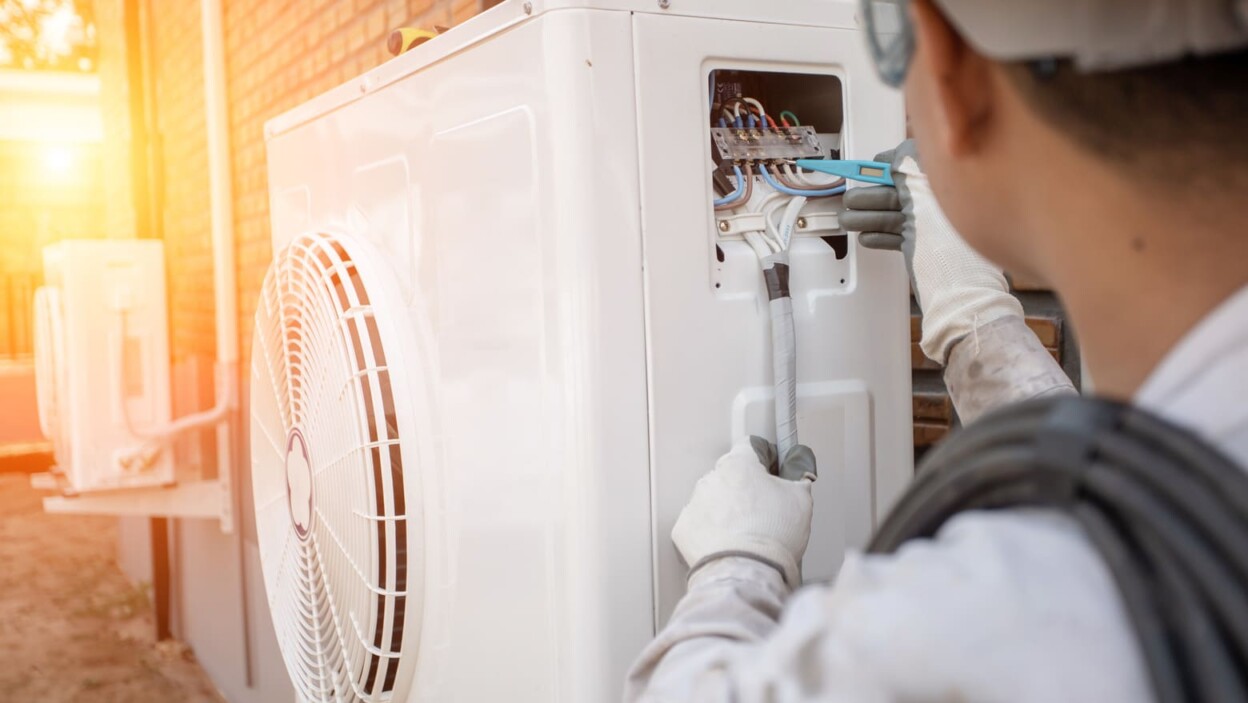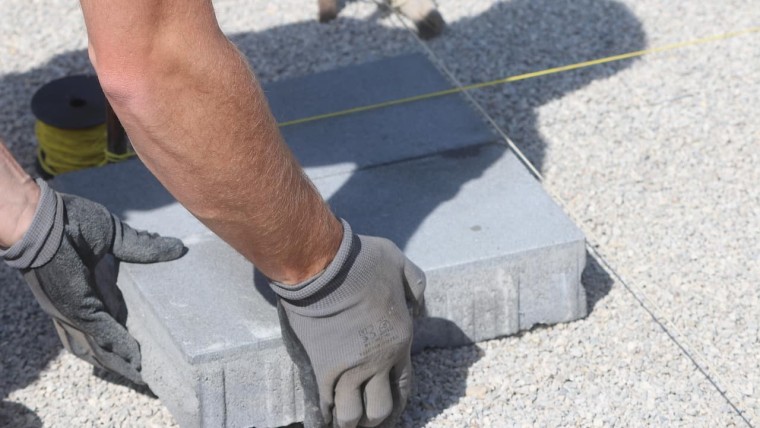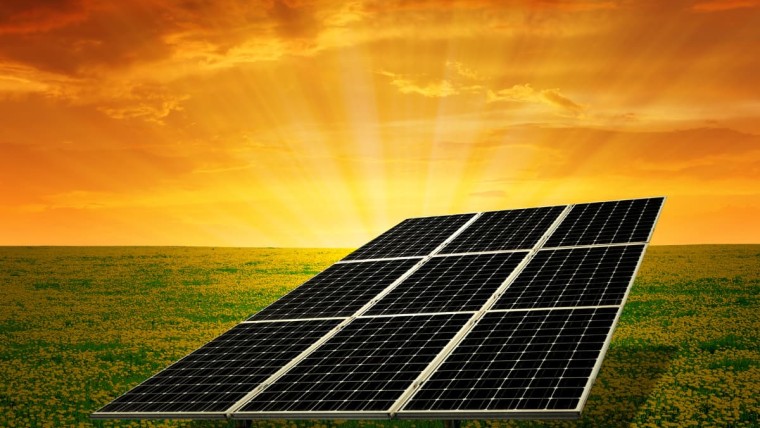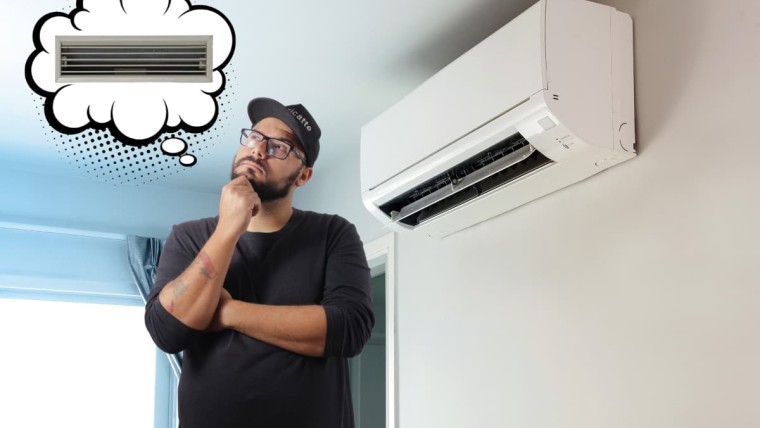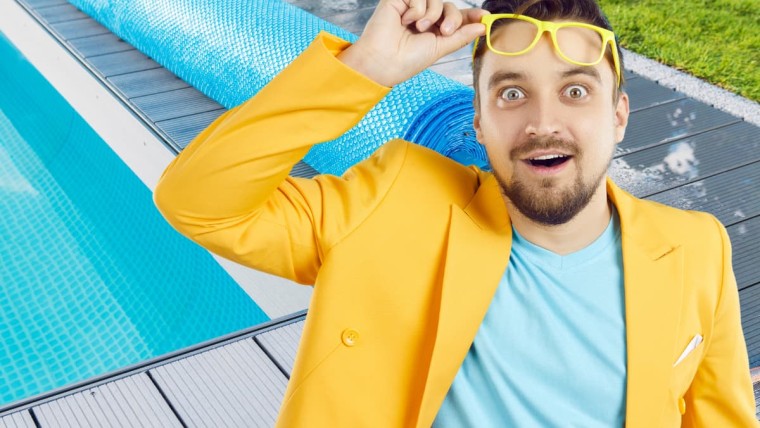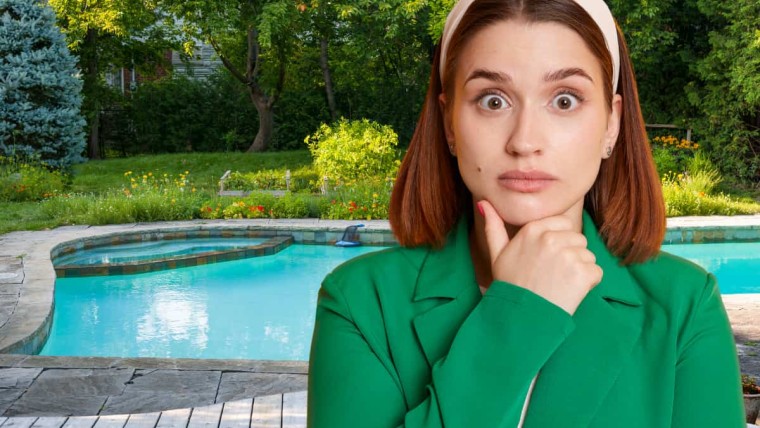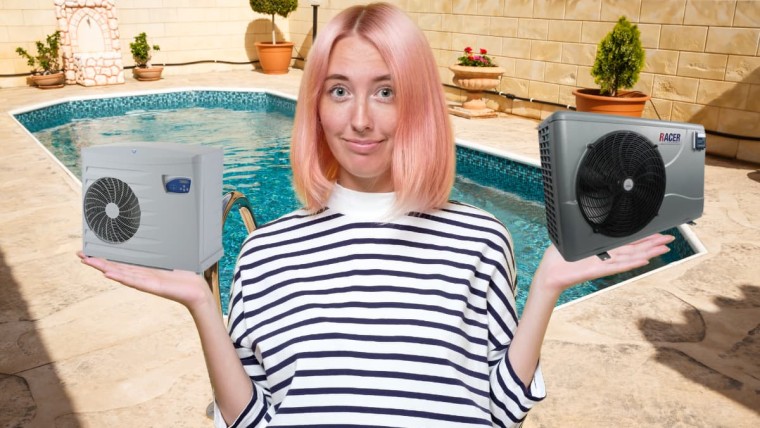Panasonic is a Japanese group based in Osaka, Japan. It dates back to 1918 and was called Matsushita at the very beginning.
The brand is specialized in electronic components, but also in refrigeration, and in the manufacture of solar components for Tesla for example.
Here, we're going to take a look at Panasonic's Aquarea heat pump model, for installation in a villa in France or any other European country. And the review focuses on the Panasonic Aquarea High Performance, which delivers water at 55°C in heating mode.
Before reading on, if you are from France, Switzerlandor BelgiumYou can request a quote from our network of certified installers, who will be happy to help you. Simply follow the quick process below:
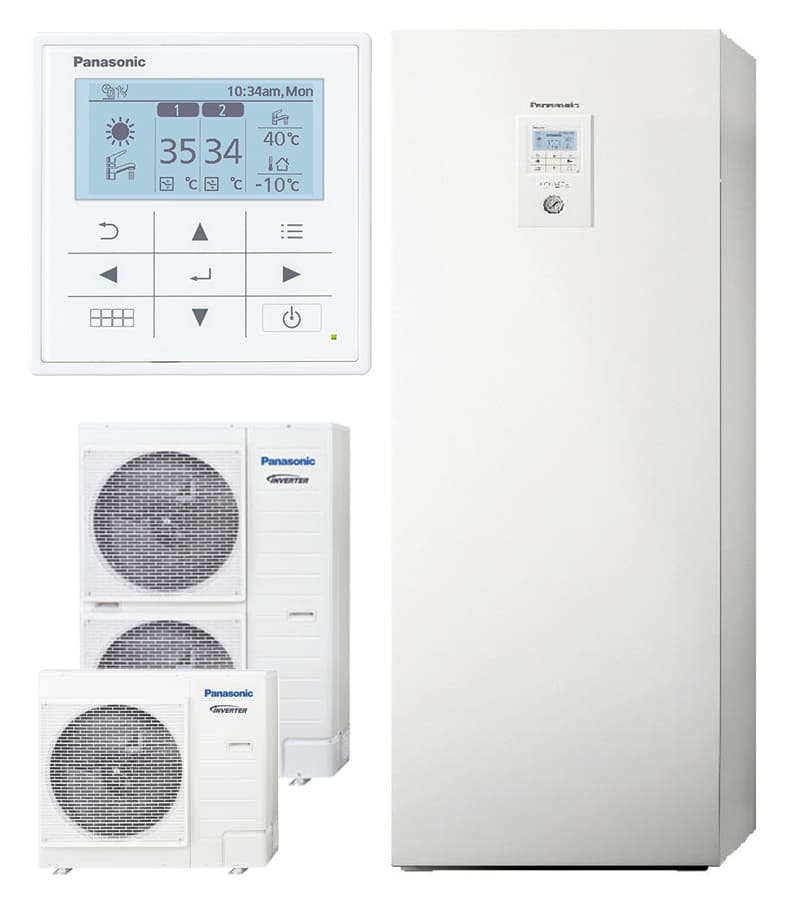
This model is found in many villas throughout Europe. It's not really the most widespread model, as are the NIBE F2120 heat pumpsor the Stiebel Eltron WPL15 heat pump in Switzerland, or the Daikin Altherma 3 in France, for example.
The model in the photo corresponds to the bi-block heat pump version (All in One) with domestic hot water. On the left, at the bottom, you can see two types of external blocks. The larger one has a heating capacity of up to 16 kW. In this block is located the refrigeration circuit. On the right is the indoor unit, which contains the condenser, and a 185L hot water tank or DHW boiler, which manages the distribution of hot water for heating in the house network. The regulation is located in the front part of this indoor unit.
To have a monobloc model in three-phase current, you have to choose the Aquarea T-CAP Monobloc Generation H version, which you can see in the picture. This model can provide a temperature of 60°C of hot water output.
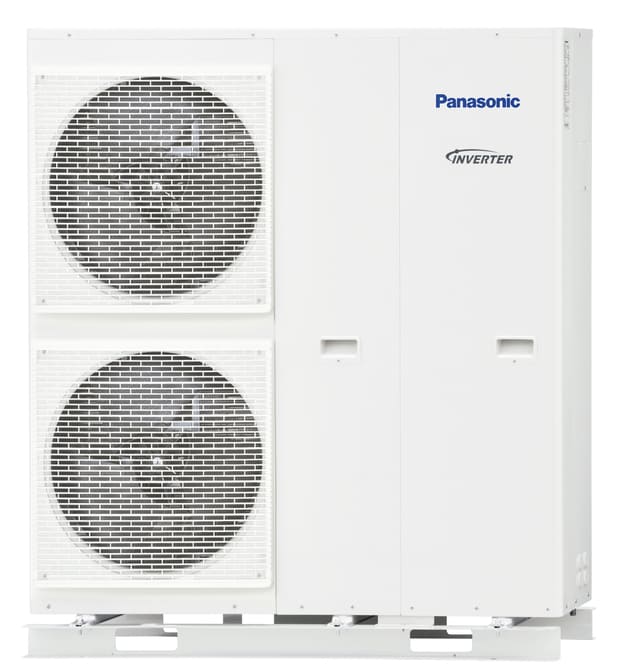
From this external block, two water pipes, outward and return, go towards the interior to distribute in the network of the house. To manage the domestic hot water, a classic DHW boiler is needed in addition.
Panasonic Aquarea T-CAP heat pump: aesthetics
- The overall appearance of the Panasonic Aquarea is modern. It's not the prettiest product on the market, but it's worth noting the effort made to produce clean, contemporary lines. It blends in well with a modern villa.
- We can't really say if in 10 or 15 years the bodywork of the outdoor unit will have kept a good look.
Performance Panasonic Aquarea T-CAP 9kW 12kW 16kW : Reviews (+ Duo model)
This model exists in two versions:
- The Panasonic Aquarea T-CAP 9kW 12kW 16kW monobloc version The entire refrigeration circuit (compressor, condenser, expansion valve, evaporator) is located in the outdoor unit. Water pipes go into the house.
- The bi-block or split version Panasonic Aquarea Dui All in One : the condenser is this time placed in the indoor module. Therefore there is a refrigeration connection from the condenser to the outdoor unit. This requires more skill on the part of the installer.
There are 3 power versions (in three-phase current) in all:
- 9kw
- 12kw
- 16kw
This allows this heat pump to be adapted to many types of housing: from apartments or very small houses, to large villas or even small buildings (16kW)
The bi-block High Performance Duo All in One version has the COP (coefficient of performance) following:
- For 9kW, at -7°C outside and 35°C hot water outlet: 2,85
- For 12kW, at -7°C outside and 35°C hot water outlet : 2,72
- For 16kW, at -7°C outside and 35°C hot water outlet : 2,49
Seen like that, the values do not seem fantastic. However, you have to keep in mind that it is very seldom -7°C during the year, even in the French part of Switzerland. The average temperature over the year is usually around 5°C. So these values are extremes. For example, the COP of 2.85 means that when the temperature is -7°C and the heat pump produces 35°C of hot water, you pay 1 kW of electricity to generate 2.85 kW of total heating power.
The data sheet available online does not give the COP for a water outlet at 55°C but it will be equal or slightly lower...so if you have an installation with radiators and you have to pass 55°C inside, it is not necessarily the best.
For the Monobloc T-CAP Generation H version, we have the same values, so the same remarks. It is given to go up to 60°C of hot water output, but the COP will be worse in this case, since it is already below 3 for a temperature of 35°C of hot water. Moreover, this monobloc version works until -15°C outside...no need to say that the COP is probably 1 and that it is therefore an electric heater. But it's rarely -15°C.... and all heat pumps are in this case: no magic.
To have a good COP even with very low temperatures, it would be necessary to make the air pass before in a Canadian well on some tens of meters to heat it...
These heat pumps are therefore well suited to modern heating networks, such as underfloor heating systems, which require a maximum of 35°C.
See the data sheets :
Panasonic Aquarea High Performance Duo All in One (bi-block)
Panasonic Aquarea T-CAP Monobloc Generation H
Acoustics of the Panasonic Aquarea heat pump: Reviews
The Duo All in One 9kW model has a sound power level of 68dBA in heating mode. In order to get building permission to install your heat pump, you will have to make some concessions. If your heat pump is in front of your building, the first window of the neighbors must be at least 20m away! Otherwise the sound pressure will be higher than what is legal in a residential area: 45dBA. Eventually, if you move the heat pump away from the facade (less reverberation), then you can install it about 15m from the neighbors to be within the limits.
But this is to be calculated with the noise circle form. You can find a help here: https://www.fws.ch/fr/nos-services/cercle-bruit/ it generates the pdf directly.
However, be careful with the most powerful model, 16kW, because the sound power rises to 72dBA. You'd better have distant neighbors so that it passes the authorization!
Same remarks for the Monobloc model.
Concerning the indoor unit of the bi-bloc model: it is very quiet...33dBA of sound pressure! Barely audible.
Starting current of the Panasonic Aquarea heat pump
The starting currents remain low, between 3.5A and 7.1A depending on the power of the machine. This makes it possible not to make any modification to the electric meter. In general it is necessary to look at this data, because a modification of the electric meter costs quickly between 2'000 and 4'000 CHF.
The Price of a Panasonic Aquarea Heat Pump
The following table gives the approximate public price as well as an idea of the average price your installer will charge you for the heat pump:
| Approx. public price CHF excl. | price on estimate install. CHF EXCL. | |
| Panasonic Aquarea High Perf. Duo All in One (bi-block) - 9kW | 10'500.- | 6'800.- |
| Panasonic Aquarea High Perf. Duo All in One (bi-block) - 12kW | 11'500.- | 7'500.- |
| Panasonic Aquarea High Perf. Duo All in One (bi-block) - 16kW | 12'800.- | 8'300.- |
| Panasonic Aquarea T-CAP Monobloc Generation H (monobloc) - 9kW | 9'800.- | 6'400.- |
| Panasonic Aquarea T-CAP Monobloc Generation H (monobloc) - 12kW | 10'400.- | 6'800.- |
| Panasonic Aquarea T-CAP Monobloc Generation H (monobloc) - 16kW | 11'500.- | 7'500 |
All these prices are only for the supply of the material. This does not take into account all the accessories and small additional equipment necessary for the installation of such a heat pump.
A minimum installation price for such a heat pump would be around CHF 25,000 in Switzerland. In France, it's more likely to cost between €15,000 and €20,000.
Availability
These rather inexpensive heat pumps are not the easiest to find. In French-speaking Switzerland, a few suppliers offer them. Your installer will probably be able to order it from them and get you behind a good price. In France, it's an easy-to-find model, available from wholesalers and other suppliers of heating equipment.
A wholesale supplier such as TCA, for example, stocks Panasonic products at https://www.optimaheat.ch/fr/optimaheat/pompes-a-chaleur/air-eau/aquarea/, or Energie-Libre at energielibre.ch. In France, you'll find them at Espace Aubade, Mano Mano, Cedeo, le comptoir des Energies...
Regulation
The regulation is super modern, as it is the case on the majority of the PAC now. We expected no less from Panasonic which is still a world leader in this field!
Box with a removable LCD screen. It acts as a thermostat in the living room for example. You can control the heat pump remotely if you are away, from the Cloud interface.
Here you have an example of how this regulation works
Footprint Panasonic Aquarea T-CAP + All in One Duo
For the Aquarea All in One Bi-Bloc version: the inner module is as big as a refrigerator: 1800 x 598 x 717mm. The outer module is taller than it is wide and still very thin: 1,340 x 900 x 320mm
For the monobloc Aquarea T-CAP: we are on a higher device and still very thin. The dimensions are 1410 x 1283 x 320mm.
Panasonic assembly quality
The assembly quality is good but does not give a fantastic impression of robustness at first glance. We can see that the production line is quite intense, with workers who probably don't have much time to dedicate to the assembly of each PAC. The operations are optimized to save time.
Nothing to do with a NIBE or a Stiebel Eltron or any other German or Scandinavian model which offers a much better quality at first sight.
If you speak a little Italian :), it is an official language in Switzerland, then you can try to understand this Italian or simply look at the pictures that take you into the interior unit of the bi-bloc model. You can then see the quality of the assembly with your own eyes.
Panasonic Technology & Accessories
On the technical side, the compressor is a Panasonic R2 rotary compressor, which is theoretically stronger than a conventional scroll compressor and can handle almost twice as many starts per hour.
The heat pump is reversible. This means that it can produce cold in summer. However, the temperature in the pipes must be regulated to avoid condensation.
Panasonic Air/Water Heat Pump Global Opinion on Aquarea T-CAP (+ Duo All in One)
The Panasonic Aquarea heat pump is an economical heat pump. The assembly quality is not the best in the world, but the durability is not affected if regular maintenance is done by a professional who has access to spare parts if needed.
The power is there, even for a 200m2 villa in Switzerland in a harsh climate, and the COP at average temperature should exceed 3 on average which is good.
If your budget does not allow you to opt for the top of the range NIBE, Stiebel Eltron or Viessmann, then the Panasonic is a choice that is close to a Daikin Altherma, and which will be able to satisfy you in the long term, to be forgotten and to ensure your comfort insofar as its installation was carried out in the rules of art.
Other Panasonic models
Panasonic is a comprehensive brand, with a range of heat pumps to cover every homeowner's needs. In 2023, a new generation of heat pumps will be launched, with the Panasonic Aquarea K & L. These models compete directly with the Daikin Altherma, with a design that's very close to it, very modern in anthracite gray. The new design contrasts with the old, rather ugly one.
An effort has also been made in terms of acoustics, with the 9kW model boasting a sound power level of 56dBA.
The L series runs on R290 (propane), which is more environmentally friendly than R410A or R32. These series can supply 75°C to ensure hygienic operation of the domestic hot water cylinder, and can maintain 55°C down to -25°C outside.
Last but not least, these new models will no longer be split, but with hydraulic or hydrosplit connection. This eliminates any leakage problems and speeds up the installation process for heating contractors.
Read also our other reviews :
You are not sure to choose Panasonic, find other brands of heat pumps :
Choosing your heat pump brand: top 20
Before committing yourself to a purchase, and if you have heat pump subsidiesCheck with the installer or supplier that the pump has the necessary certificates. For example, if a PAC System Modul certificate is required.

Julien G.
Juliena mechanical engineering graduate and specialist in climate engineering since 2009, has become a writer specializing in renewable energies, with expertise in heat pumps and photovoltaic solar panels for individual housing.
See all articles by this author
